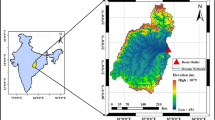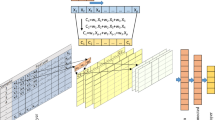Abstract
Accurate forecasts of hourly water levels during typhoons are crucial to disaster emergency response. To mitigate flood damage, the development of a water-level forecasting model has played an essential role. We propose a model based on a dilated causal convolutional neural network (DCCNN) that can yield water-level forecasts with lead times of 1- to 6-h. A DCCNN model can efficiently exploit a broad-range history. Residual and skip connections are also applied throughout the network to enable training of deeper networks and to accelerate convergence. To demonstrate the superiority of the proposed forecasting technique, we applied it to a dataset of 16 typhoon events that occurred during the years 2012–2017 in the Yilan River basin in Taiwan. In order to examine the efficiency of the improved methodology, we also compared the proposed model with two existing models that were based on the multilayer perceptron (MLP) and the support vector machine (SVM). The results indicate that a DCCNN-based model is superior to both the SVM and MLP models, especially for modeling peak water levels. Much of the performance improvement of the proposed model is due to its ability to provide water-level forecasts with a long lead time. The proposed model is expected to be particularly useful in support of disaster warning systems.











Similar content being viewed by others
References
Alipanahi B, Delong A, Weirauch MT, Frey BJ (2015) Predicting the sequence specificities of DNA-and RNA-binding proteins by deep learning. Nat Biotechnol 33(8):831–838
Beven K, Kirkby MJ (1979) A physically based, variable contributing area model of basin hydrology. Hydrol Sci Bull 24:43–69
Borovykh A, Bohte S, Oosterlee CW (2017) Conditional time series forecasting with convolutional neural networks. In Proc 26th International Conference on Artificial Neural Networks, arXiv:1703.04691
Chang LC, Shen HY, Chang FJ (2014) Regional flood inundation nowcast using hybrid SOM and dynamic neural networks. J Hydrol 519:476–489
Farzad F, El-Shafie AH (2017) Performance enhancement of rainfall pattern–water level prediction model utilizing self-organizing-map clustering method. Water Resour Manag 31(3):945–959
Feng Q, Wen X, Li J (2015) Wavelet analysis-support vector machine coupled models for monthly rainfall forecasting in arid regions. Water Resour Manag 29(4):1049–1065
He K, Zhang X, Ren S, Sun J (2016) Deep residual learning for image recognition. In Proc the IEEE conference on computer vision and pattern recognition, arXiv:1512.03385
Hinton GE, Osindero S, Teh YW (2006) A fast learning algorithm for deep belief nets. Neural Comput 18(7):1527–1554
Hipni A, El-shafie A, Najah A, Karim OA, Hussain A, Mukhlisin M (2013) Daily forecasting of dam water levels: comparing a support vector machine (SVM) model with adaptive neuro fuzzy inference system (ANFIS). Water Resour Manag 27(10):3803–3823
Hochreiter S, Schmidhuber J (1997) LSTM can solve hard long time lag problems. In Advances in neural information processing systems 9, MIT Press, Cambridge MA, pp 473–479
Jing Y, Bian Y, Hu Z, Wang L, Xie XQ (2018) Deep learning for drug design: an artificial intelligence paradigm for drug discovery in the big data era. AAPS J 20:58
Jhong BC, Wang JH, Lin GF (2017) An integrated two-stage support vector machine approach to forecast inundation maps during typhoons. J Hydrol 547:236–252
Krizhevsky A, Sutskever I, Hinton GE (2012) Imagenet classification with deep convolutional neural networks. In Advances in neural information processing systems 25, pp 1090–1098
Kumar S, Tiwari MK, Chatterjee C, Mishra A (2015) Reservoir inflow forecasting using ensemble models based on neural networks, wavelet analysis and bootstrap method. Water Resour Manag 29(13):4863–4883
LeCun Y, Bengio Y (1995) Convolutional networks for images, speech, and time series. The handbook of brain theory and neural networks, MIT Press, Cambridge MA, pp 255–257
LeCun Y, Bengio Y, Hinton G (2015) Deep learning. Nature 521(7553):436–444
Lin GF, Chen GR, Huang PY, Chou YC (2009) Support vector machine-based models for hourly reservoir inflow forecasting during typhoon-warning periods. J Hydrol 372(1–4):17–29
Lin GF, Jhong BC, Chang CC (2013) Development of an effective data-driven model for hourly typhoon rainfall forecasting. J Hydrol 495:52–63
Liong SY, Lim WH, Paudyal GN (2000) River stage forecasting in Bangladesh: neural network approach. J Comput Civ Eng 14(1):1–8
Moore RD, Thompson JC (1996) Are water table variations in a shallow forest soil consistent with the TOPMODEL concept? Water Resour Res 32(3):663–669
Nandi A, Mandal A, Wilson M, Smith D (2016) Flood hazard mapping in Jamaica using principal component analysis and logistic regression. Environ Earth Sci 75:465
Nguyen PKT, Chua LHC (2012) The data-driven approach as an operational real-time flood forecasting model. Hydrol Process 26(19):2878–2893
Rumelhart DE, Hinton GE, Williams RJ (1986) Learning representations by back-propagating errors. Nature 323:318–362
Sari V, dos Reis Castro NM, Pedrollo OC (2017) Estimate of suspended sediment concentration from monitored data of turbidity and water level using artificial neural networks. Water Resour Manag 31(15):4909–4923
Seibert J (2000) Multi-criteria calibration of a conceptual runoff model using a genetic algorithm. Hydrol Earth Syst Sci 4(2):215–224
Seyoum SD, Vojinovic Z, Price RK, Weesakul S (2012) Coupled 1D and noninertia 2D flood inundation model for simulation of urban flooding. J Hydraul Eng 138(1):23–34
Sun W, Trevor B (2018) Multiple model combination methods for annual maximum water level prediction during river ice breakup. Hydrol Process 32(3):421–435
Tehrany MS, Pradhan B, Jebur MN (2014) Flood susceptibility mapping using a novel ensemble weights-of-evidence and support vector machine models in GIS. J Hydrol 512:332–343
van den Oord A, Dieleman S, Zen H, Simonyan K, Vinyals O, Graves A, Kalchbrenner N, Senior A, Kavukcuoglu K (2016a) WaveNet: A generative model for raw audio. In Proc 9th ISCA Speech Synthesis Workshop, arXiv:1609.03499
van den Oord A, Kalchbrenner N, Kavukcuoglu K (2016b) Pixel recurrent neural networks." In Proc 33rd International Conference on Machine Learning, arXiv:1601.06759
Vapnik V (1995) The nature of statistical learning theory. Springer, New York
Vapnik V (1998) Statistical learning theory. Wiley, New York
Yao C, Zhang K, Yu Z, Li Z, Li Q (2014) Improving the flood prediction capability of the Xinanjiang model in ungauged nested catchments by coupling it with the geomorphologic instantaneous unit hydrograph. J Hydrol 517:1035–1048
Yu F, Koltun V (2016) Multi-scale context aggregation by dilated convolutions. In Proc International Conference on Learning Representations, arXiv:1511.07122
Yu PS, Chen ST, Chang IF (2006) Support vector regression for real-time flood stage forecasting. J Hydrol 328:704–716
Zeiler MD, Fergus R (2014) Visualizing and understanding convolutional networks. In Proc 13th European conference on computer vision, Springer, Cham, pp 818–833
Zwenzner H, Voigt S (2009) Improved estimation of flood parameters by combining space based SAR data with very high resolution digital elevation data. Hydrol Earth Syst Sci 13(5):567–576
Author information
Authors and Affiliations
Corresponding author
Ethics declarations
Conflict of Interest
None.
Additional information
Publisher’s Note
Springer Nature remains neutral with regard to jurisdictional claims in published maps and institutional affiliations.
Rights and permissions
About this article
Cite this article
Wang, JH., Lin, GF., Chang, MJ. et al. Real-Time Water-Level Forecasting Using Dilated Causal Convolutional Neural Networks. Water Resour Manage 33, 3759–3780 (2019). https://doi.org/10.1007/s11269-019-02342-4
Received:
Accepted:
Published:
Issue Date:
DOI: https://doi.org/10.1007/s11269-019-02342-4




